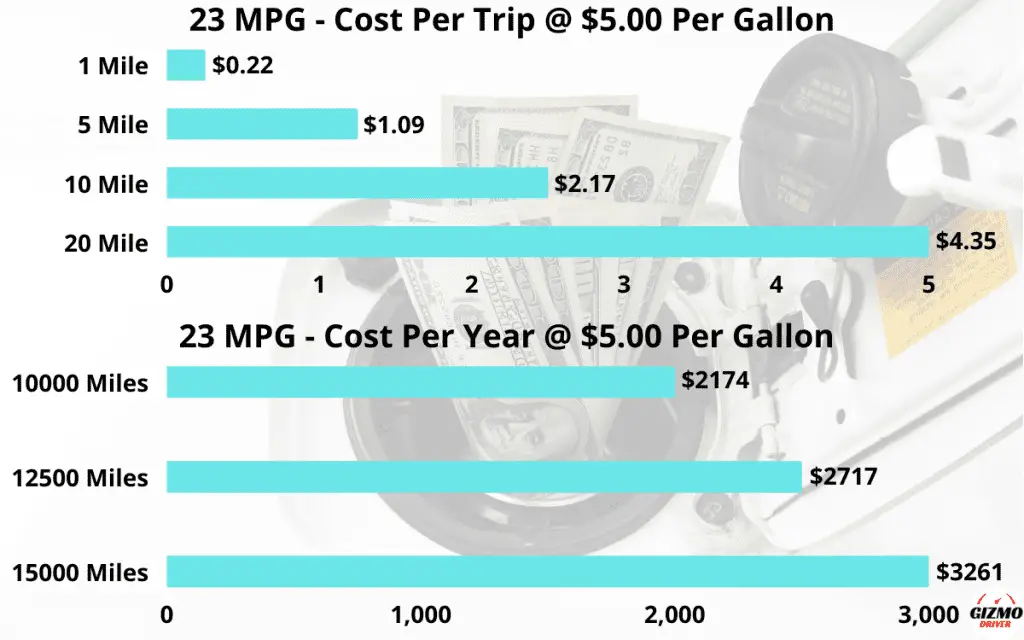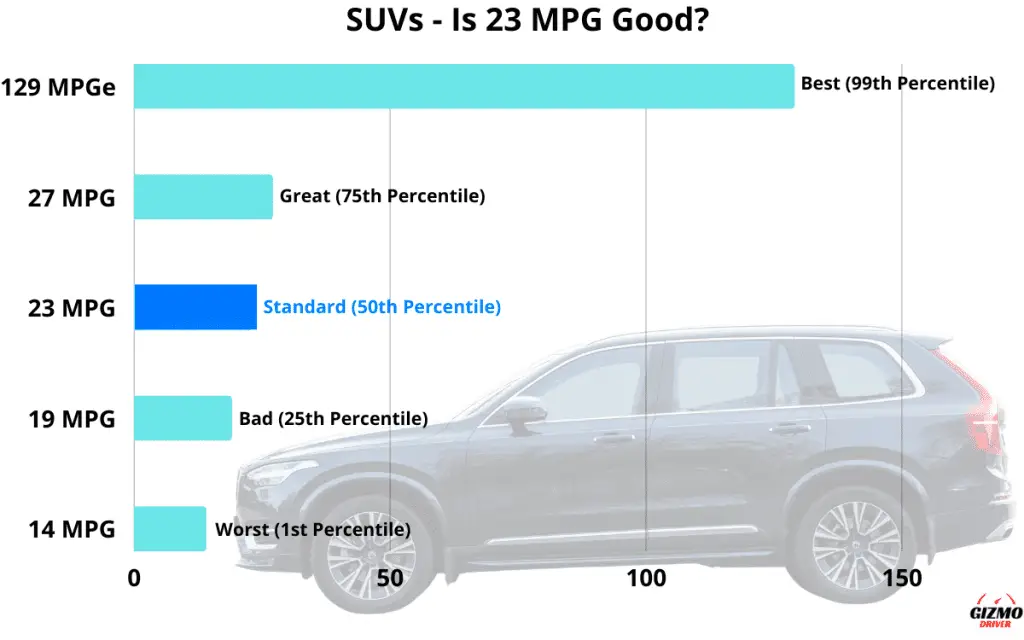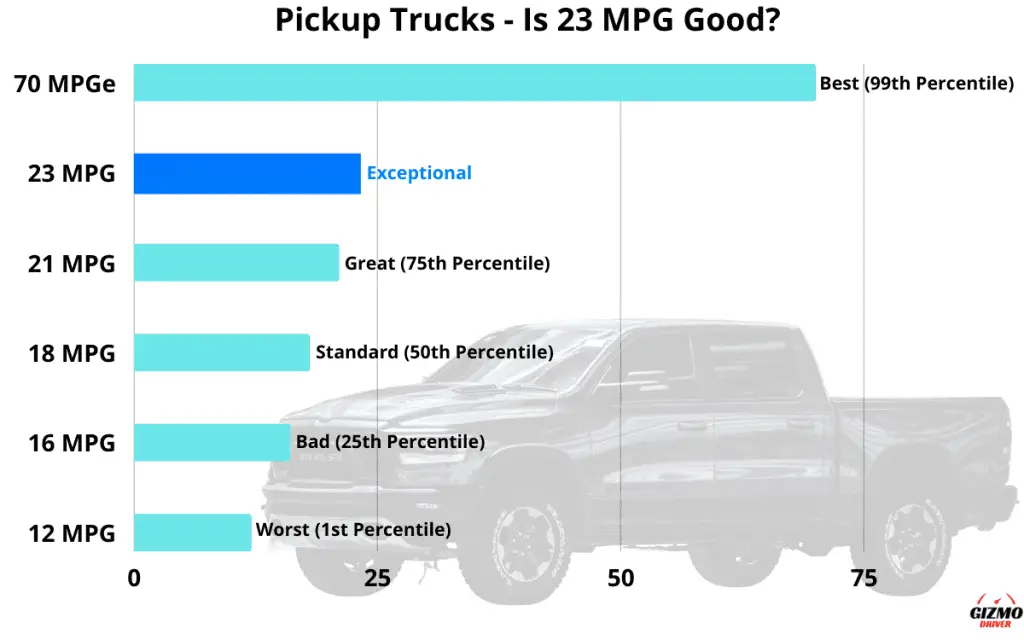*The values used in this article are as of 2022-2023.
In this article, we’ll examine whether 23 MPG, or 10.23 L/100 km, is a reasonable fuel economy for a general automobile, and then we will discuss 23 MPG for specific vehicle types.
The focus will be on combined fuel economy. We will, however, briefly discuss city and highway fuel economy.
Is 23 MPG Good?

Summary:
23 miles per gallon is the average gas mileage. The median (50th percentile) fuel economy for all passenger vehicles is 23 miles per gallon. For specific vehicle types, 23 MPG is good for large SUVs, pickup trucks, sports cars, and full-size sedans.
The table below shows how good 23 MPG is for different types of vehicles.
| Vehicle Type | Median Fuel Economy | 23 MPG is | 23 MPG/Median Difference |
|---|---|---|---|
| All Automobiles | 23 | Standard | 0.00% |
| Sedan | 28 | Bad | – 17.86% |
| Small SUV | 27 | Bad | – 14.81% |
| Large SUV | 21 | Good | + 9.52% |
| Sports Cars | 19 | Excellent | + 21.05% |
| Pickup Truck | 18 | Exceptional | + 27.78% |

As we can see in this chart, 23 MPG is above the 50th percentile for 6 of the major vehicle categories: full-size SUVs, full-size pickup trucks, sports cars (coupes), mid-size pickup trucks, mid-size SUVs, and full-size sedans.
The median is a better measure of assessing whether or not 23 MPG is good. Electric vehicles and plug-in hybrids can significantly inflate average gas mileage values.
For example, we calculated that the average (mean) MPG for a pickup truck is 20.6 miles per gallon. However, 20.6 MPG is above the 70th percentile for all pickup trucks. That means for every 10 pickup trucks, 7 get lower gas mileage than the average of 20.6.
The median MPG, or 50th percentile, much better reconciles the large efficiency gap between electric and gas-powered vehicles.
23 MPG City
23 MPG in the city is considered good. It is 3 MPG, or 15% better than the gas mileage of the median car (50th percentile), which gets average gas mileage of 20 MPG in the city.
However, for a car with a regenerative braking system, 23 MPG in the city is just about average. The 50th percentile city fuel economy for a hybrid car(MHEV/HEV) is 23 MPG.
Usually, fuel efficiency in city traffic is worse than on the highway. Full-hybrid vehicles, on the other hand, are often more efficient in the city than on the highway due to regenerative braking systems.
23 MPG Highway
23 MPG on the highway is not a good fuel economy. It is considerably lower than the 50th percentile of highway fuel economy, which is 27 MPG. That’s a difference of 4 miles per gallon. For most vehicles, 23 MPG on the highway translates to 19 MPG combined (city and highway), which is also considered bad.
The cost of 23 MPG

At 23 MPG, you spend just about as much as the average American would on gas.
At $5.00 per gallon, a vehicle that gets 23 MPG will generally cost you $0.22 per mile. A 15-mile commute to work will cost you $3.21 in gas.
When driving 15,000 miles per year, the annual cost of fuel for a car that gets 23 MPG is $3,261. At 23 MPG, you are at the 50th percentile of gas spending.
How many miles is 23 MPG
MPG indicates how many miles your car can travel on one gallon of fuel. If your vehicle gets 23 MPG, it can travel 23 miles for each gallon of fuel. A vehicle with a fuel tank capacity of 15 gallons and a gas mileage of 23 MPG can travel up to 345 miles before needing to refuel.
23 MPG in L/100 km
23 MPG is 10.23 L /100 km. That means you burn 10.23 liters of gas for every 100 kilometers driven.
At 10.23 L/100 km, you can go 9.78 km with one liter of gas.
23 MPG on SUVs

In general, gas mileage of 23 MPG is considered standard for SUVs. But, just like with any other type of vehicle, there are a lot of things to consider before determining if 23 MPG is a good fuel economy for any given SUV.
For instance, 23 MPG might be great for a mid-size SUV with a V6 engine, but terrible for a mid-size hybrid SUV with only 4 cylinders.
There are 2 main categories and 4 subcategories for SUVs: full-size and mid-size SUVs fall into the large SUV category, while compact and subcompact SUVs fall into the small SUV category.
To get a better idea of what you can consider good fuel economy for an SUV, please check out our articles covering the fuel economies of large SUVs and small SUVs.
We’ll take a look at each subcategory.
Full-size SUVs:
23 MPG is excellent fuel economy for a full-size SUV. That’s 35.3% more miles per gallon than the median for the segment, which is 17 miles per gallon. They are the least fuel-efficient type of passenger vehicle. A full-size SUV that gets 23 MPG is better than 95% of full-size SUVs.
23 MPG or above is usually seen in the most fuel-efficient full-size SUVs, typically fitted with diesel engines.
The 2023, 3.0 L, 6-cylinder diesel-engine GMC Yukon (2WD) is one of the few full-sized SUVs that can achieve an average gas mileage of 23 MPG.
Mid-size SUVs:
For a mid-size SUV, 23 MPG is considered good gas mileage. The median fuel economy for this segment is 21 miles per gallon.
23 MPG is usually seen in 4-cylinder mid-size SUVs. The median fuel economy for 4-cylinder mid-sized SUVs is 23 MPG.
An example of an SUV that gets 23 miles per gallon is the 2023 BMW X5 sDrive40i with a 3.0 L, 6-cylinder.
Compact SUVs:
For compact SUVs, gas mileage of 23 MPG is considered poor. It is 8% lower than the average fuel economy of the median compact SUV and is at the 25th percentile. The median fuel economy for this segment is 25 MPG.
23 MPG is most often seen in the more fuel-efficient 6-cylinder and least-efficient 4-cylinder compact SUVs.
An example of a compact SUV that gets 23 MPG is the 2023 Jaguar E-Pace, which carries a 2.0 L 4-cylinder engine.
Subcompact SUVs:
23 MPG is a terrible gas mileage for a subcompact SUV. There are very few subcompact SUVs that are supposed to get 23 MPG or lower. The average (median) gas mileage for this segment is 30 miles per gallon.
If you are getting 23 MPG or less on a subcompact SUV, it is likely due to poor driving habits or road conditions.
The 2023 2.0 L, 4-cylinder Hyundai Kona N, gets 23 MPG. It is also the subcompact SUV with the 2nd lowest gas mileage after the Mercedes-Benz AMG GLA45 (22 MPG).
23 MPG on Pick-up Trucks

23 MPG is an excellent gas mileage for the average pickup truck. As we can see in the chart above, 23 MPG is between the 75th and 99th percentile of fuel economy for all pickup trucks.
However, the type of pickup truck you drive has a significant impact on whether or not 23 MPG is a good MPG for your vehicle. For example, the median mid-size gasoline pickup truck is 16 percent more efficient than its full-size counterpart.
Typically, larger engines in pickup trucks are expected to have lower fuel efficiency than smaller engines in pickup trucks.
To get a better idea of what you can consider good fuel economy for pickup trucks, please check out our articles covering the fuel economies of mid-size and full-size pickup trucks.
Full-size trucks:
23 MPG is an exceptional fuel economy for a full-size pickup truck. A full-size pickup doing 23 miles per gallon is 27.8% more fuel-efficient than the median full-size pickup truck, which does 18 MPG.
23 MPG is generally seen in full-size pickup trucks that have hybrid or diesel engines. The average fuel economy for hybrid and diesel pickup trucks is 22.8 MPG and 24 MPG, respectively.
An example of a full-size pickup truck that gets 23 MPG is the RAM 1500 HFE (2WD), which houses a 3.6 L, 6-cylinder hybrid engine.
Mid-size trucks:
23 MPG is a good fuel economy for a midsize pickup truck. It is above the 75th percentile of the gas mileage for all midsize pickup trucks. The median gas mileage for a mid-size pickup truck is 21 miles per gallon.
23 MPG is usually seen on mid-size trucks with 4-cylinder engines. An example of a mid-size pickup truck that gets 23 MPG is the 2.3 L, 4-cylinder Ford Ranger (2WD).
The absence of V8 engines in mid-size pickup trucks is primarily responsible for the significant difference between full-size and mid-size. A large proportion (40-50%) of full-size pickup truck models are equipped with V8 engines, which have very low gas mileage, averaging 16 miles per gallon.
However, when fitted with the same engine, mid-size pickup trucks have very similar fuel economy as their full-size counterparts despite the weight difference.
Full-size pickup trucks have a much larger market share than mid-size pickup trucks, and as a result, more effort is put into making them as fuel-efficient as possible.
23 MPG on Sedans

As we can see in the above chart, which illustrates the different percentile ranges for sedans, 23 MPG is considered poor gas mileage for a sedan in general.
Of course, the answer will vary depending on the type of sedan being driven. For example, 23 MPG could be great for a large, luxurious, V6-powered performance sedan, but terrible for a small sedan with a four-cylinder engine.
To get a better idea of what you can consider good fuel economy for sedans, please see our article covering the fuel economies of every type of sedan vehicle.
Full-size sedans:
23 MPG is considered a slightly above-average gas mileage for full-size sedans. It is 2 MPG greater than the median for the segment, which is 21 MPG. Full-size sedans typically get gas mileage between 19 and 25 MPG (25th and 75th percentiles). Anything below this range is bad, while anything above is great.
You can generally expect the most efficient 6-cylinder full-size sedans to do 23 MPG.
An example of a full-size sedan that does 23 miles per gallon is the 3.6 L, 6-cylinder Dodge Charger.
Mid-size sedans:
23 MPG is considered bad for a mid-size sedan. The median fuel economy for a mid-size is 26 MPG, which is 11.3% higher than 23 MPG.
Most mid-size sedans that get 23 MPG have 6-cylinder engines. An example of this would be the 2023 3.0 L, 6-cylinder Infinity Q50.
Small sedans (including hatchbacks):
23 MPG is horrible fuel economy for compact sedans or hatchbacks. These cars normally do between 28 and 35 miles per gallon, with the median being 31.5 miles per gallon. Getting 23 MPG with a small sedan is likely due to poor driving habits.
Much like subcompact SUVs, most small/compact 4-5 door cars should not be getting 23 MPG.
An example of a compact car that gets 23 MPG is the 2.0 L, 4-cylinder Hyundai Elantra N.
Please note that for our calculations, we’ve counted some luxury sedans that are labeled compact sedans (such as the Mercedes C-Class, Genesis G70, or BMW 3 Series) as mid-size sedans. These cars are much closer in size to conventional mid-size sedans.
23 MPG on Sports Cars

23 MPG is above the 75th percentile for sports cars and is considered excellent gas mileage. The median sports car does 19 miles per gallon.
23 miles per gallon is great for sports vehicles with large engines like the V8, V10, V12, and W16; good for 6-cylinder sports cars; and poor for those with 4-cylinder engines. A 6-cylinder sports car’s average fuel economy is 21 mpg.
A sports car that gets 23 MPG is the 2.3 L, 4-cylinder Ford Mustang HO Coupe.
Conclusion
In general, 23 MPG is an average gas mileage. However, whether or not it’s a good fuel economy largely comes down to the type of vehicle you are driving. For full-size pickup trucks, full-size SUVs, and sports cars, 23 MPG is considered excellent; for mid-size pickup trucks, full-size sedans, and mid-size SUVs, it is considered good.
Sources

